The fundamental advantage of biodiesel is that it can be depicted as "carbon impartial". This implies the fuel creates no net yield of carbon as carbon dioxide (CO2). This impact happens in light of the fact that when the oil crop develops it assimilates the same measure of CO2 as is discharged when the fuel is combusted.
India is the largest producer of oilseeds in the world and the oilseed sector occupies an important position in the country’s economy. The country accounts for 12-15 per cent of global oilseeds area, 6-7 per cent of vegetable oils production, and 9-10 per cent of the total edible oils consumption. The area and production under the nine oilseeds was 26.11 million ha and 24.88 Mt, respectively in 2009-10, whereas the total edible oil production in the country stood at 6.17 Mt in 2009-10. As per the fourth advance estimates for 2010-11, the production of total nine oilseed crops is 31.10 Mt, which is a quantum jump over previous year’s production. Oilseeds area and output are concentrated in the central and southern parts of India, mainly in the states of Madhya Pradesh, Gujarat, Rajasthan, Andhra Pradesh and Karnataka. In India, edible oil consumption has been growing steadily over the years. From around 5 Mt in 1990-91, the aggregate consumption of edible oils has gone up to 14 Mt in 2009-10. Groundnut, rapeseed-mustard, soybean and palm oil account for around 60 per cent of the edible oils consumed in the country.
In rural and urban India consumption of all edible oils per month increased from 0.37 kg and 0.56 kg respectively, in 1993-94 to 0.64 kg and 0.82 kg in 2009-10. This translates into an increase of 72 per cent and 46 per cent, respectively, among rural and urban households. The edible oils requirement of the country has been projected at 16.34 Mt in 2016-17 and 20.36 Mt in 2020-21, i.e. at the end of 12th Plan and 13th Plan, respectively.
Inhaltsverzeichnis (Table of Contents)
- Introduction to Bio-Diesel:
- Production of Bio-Diesel:
- Bio-Diesel Benefits:
- Scope and objectives of the study:
- Transesterification :
- Oil Extraction Technique:
- Extraction of fatty oil:
- Mechanical Screw Method:
- Organic Solvent extraction method:
- Microwave Assisted Extraction Method:
- Ultrasound Assisted Oil Extraction Method:
- Combined Microwave and Ultrasonic-Assisted Oil Extraction Method:
- Cultivation:
- Copra:
- Coconut:
- SUNFLOWER:
- SOYBEAN:
- Rice:
- Cotton seed:
- Rapeseed:
- Camelina:
- Oil Extraction:
- Edible Seeds
- Coconut:
- Seedcake content in copra:
- Seedcake content in soybean:
- Seedcake of sunflower:
- Seedcake of Rice:
- Seedcake of cotton seed:
- Rapeseed:
- Camelina:
- Conclusion:
Zielsetzung und Themenschwerpunkte (Objectives and Key Themes)
This study aims to comprehensively analyze the oilseed economy of India, considering the multifaceted roles of various stakeholders, including cultivators, processors, consumers, and intermediaries. The study intends to provide a thorough assessment of the present and future edible oil needs of the country, exploring production, yield, trade, and economic implications. The primary objective is to develop strategies to increase domestic oilseed production and achieve self-sufficiency in edible oil production.
- Assessment of India's edible oil demand and supply scenario
- Analysis of current oilseed production and its limitations
- Evaluation of the impact of oilseed trade on the Indian economy
- Development of strategies to enhance oilseed production and achieve self-reliance
- Exploration of the potential of biodiesel as a sustainable alternative fuel
Zusammenfassung der Kapitel (Chapter Summaries)
The report begins with an introduction to biodiesel, outlining its production from various sources and its environmental benefits. Chapter 2 delves into the production process of biodiesel, focusing on the transesterification method, which involves reacting triglycerides with alcohol to produce biodiesel and glycerol. Chapter 3 highlights the environmental advantages of biodiesel, emphasizing its carbon-neutral nature and biodegradability.
The study delves into the scope and objectives of the research in chapter 4, emphasizing the importance of analyzing the oilseed economy's complex dynamics and the need for policy interventions to ensure the sector's sustainability. Chapter 5 examines the transesterification process in detail, explaining the chemical reactions involved. Chapter 6 focuses on oil extraction techniques, presenting various methods like mechanical screw pressing, organic solvent extraction, and microwave and ultrasound-assisted extraction.
Chapter 7 explores the cultivation of various oilseed crops, including copra, coconut, sunflower, soybean, rice, cottonseed, rapeseed, and camelina. The report discusses the production of seedcake as a by-product of oil extraction from various seeds in Chapter 9, highlighting its potential applications in animal feed and other industries.
Schlüsselwörter (Keywords)
The primary keywords associated with this study are: biodiesel, oilseeds, edible oils, transesterification, oil extraction, cultivation, seedcake, sustainability, carbon neutrality, economic impact, policy interventions, India, demand and supply, self-reliance.
- Quote paper
- Anonym (Author), 2016, The extraction of Biodiesel. Oil extraction, cultivation and seed cake for various types of edible oil seeds, Munich, GRIN Verlag, https://www.hausarbeiten.de/document/541344


